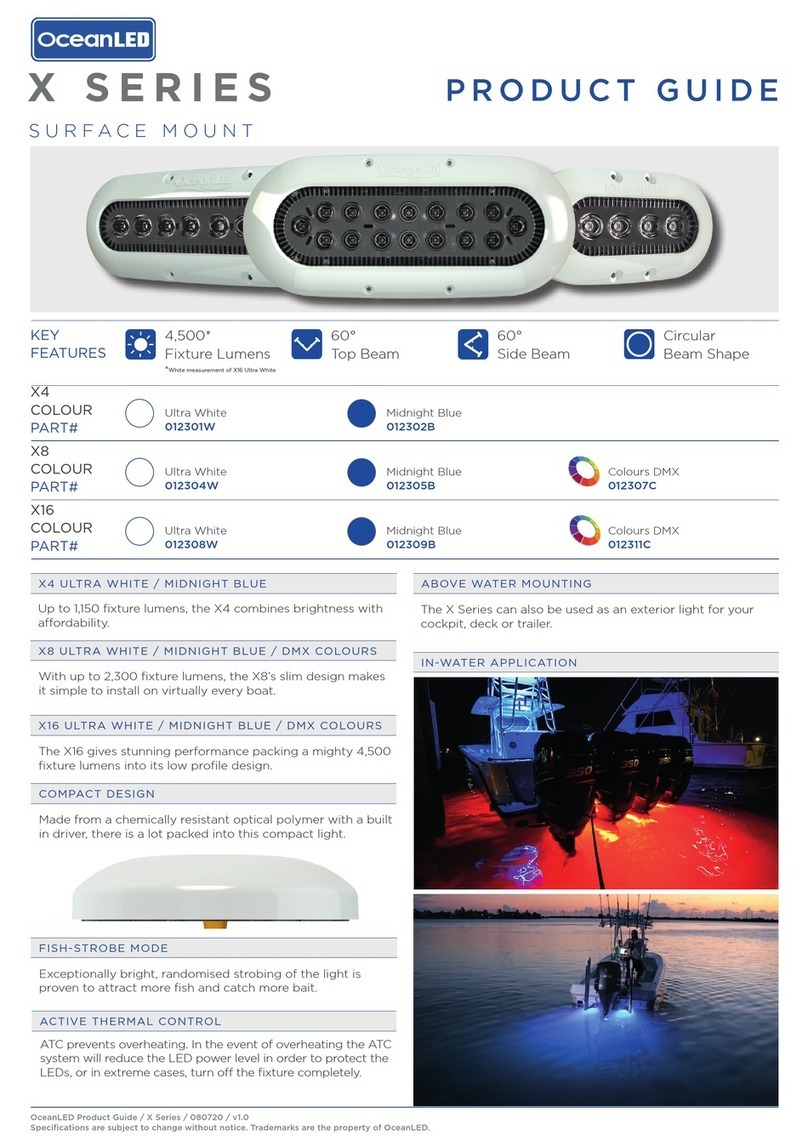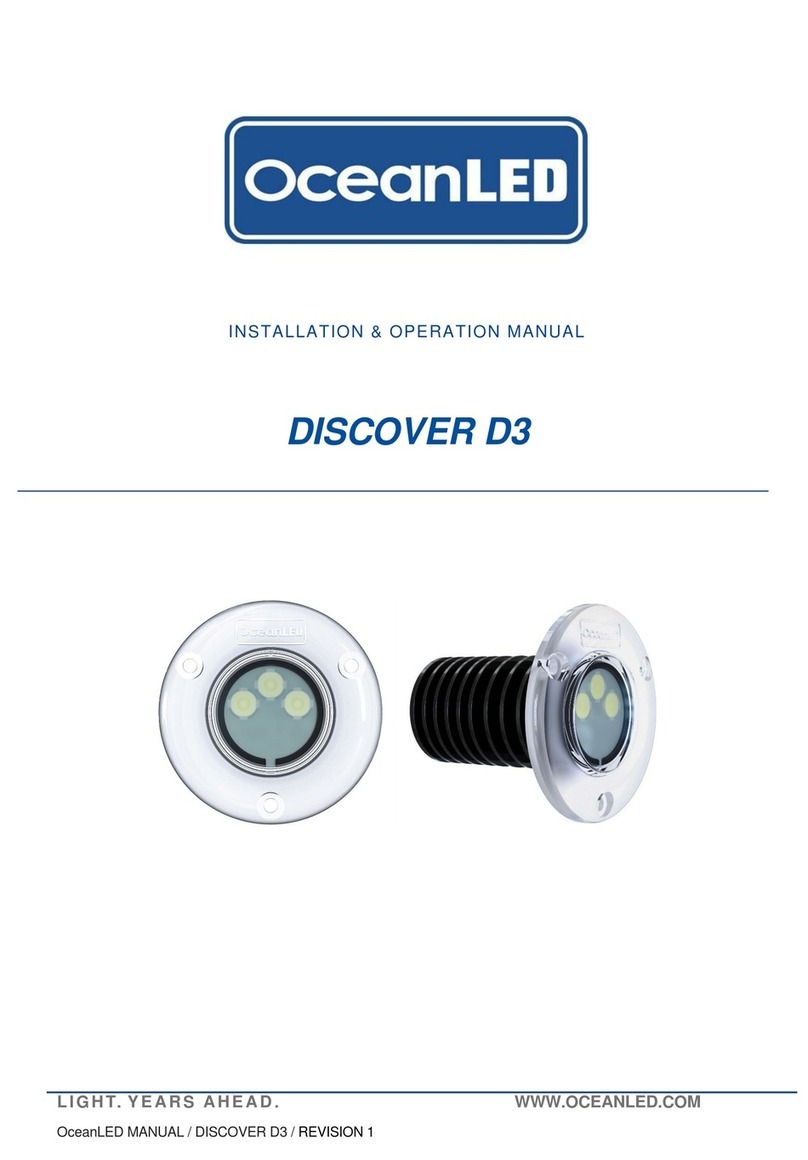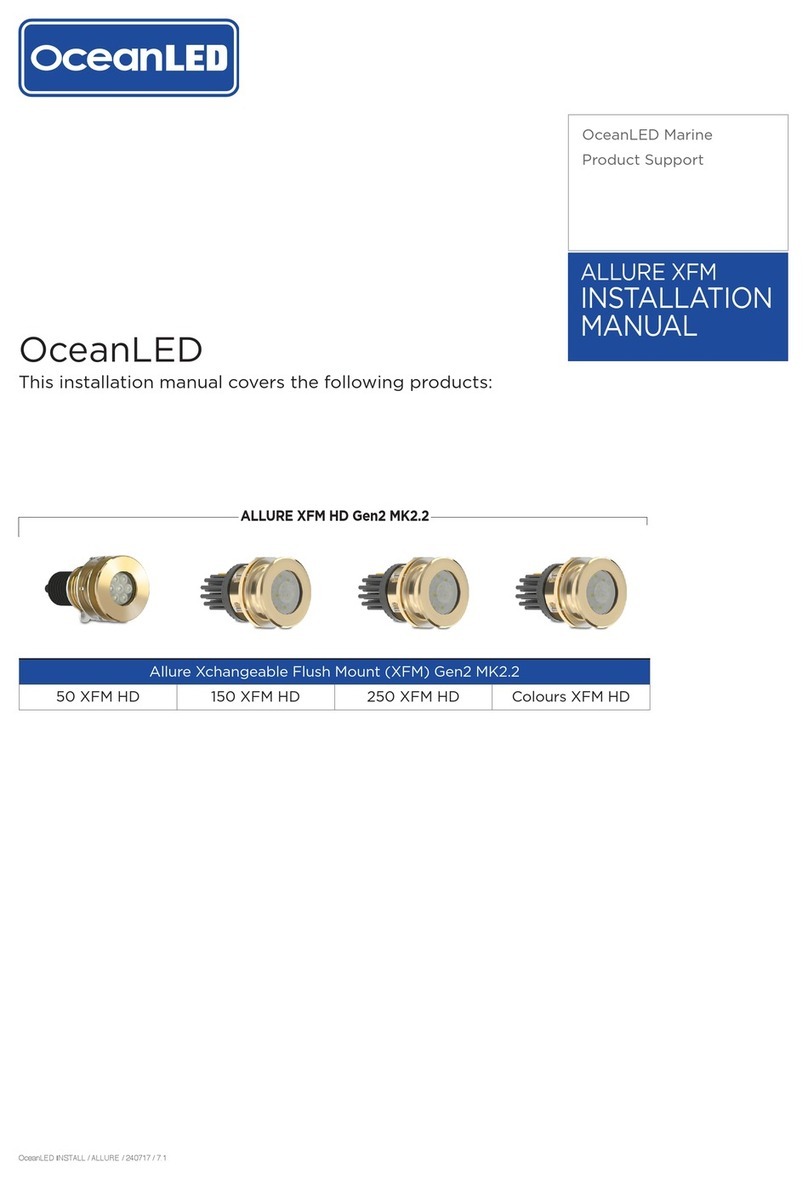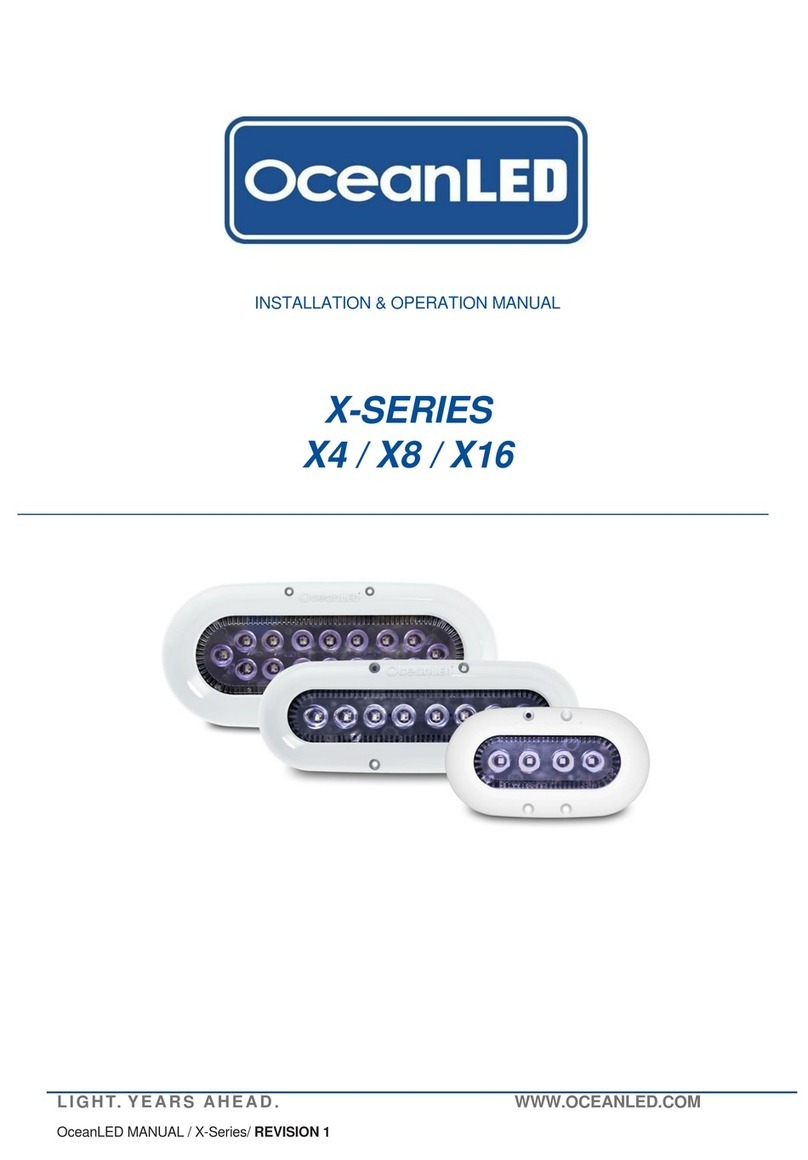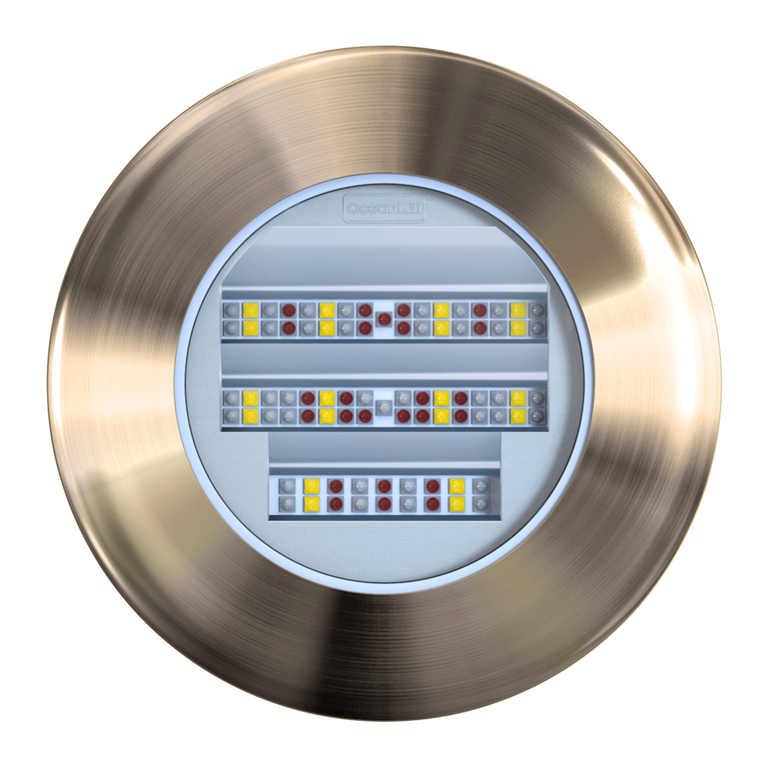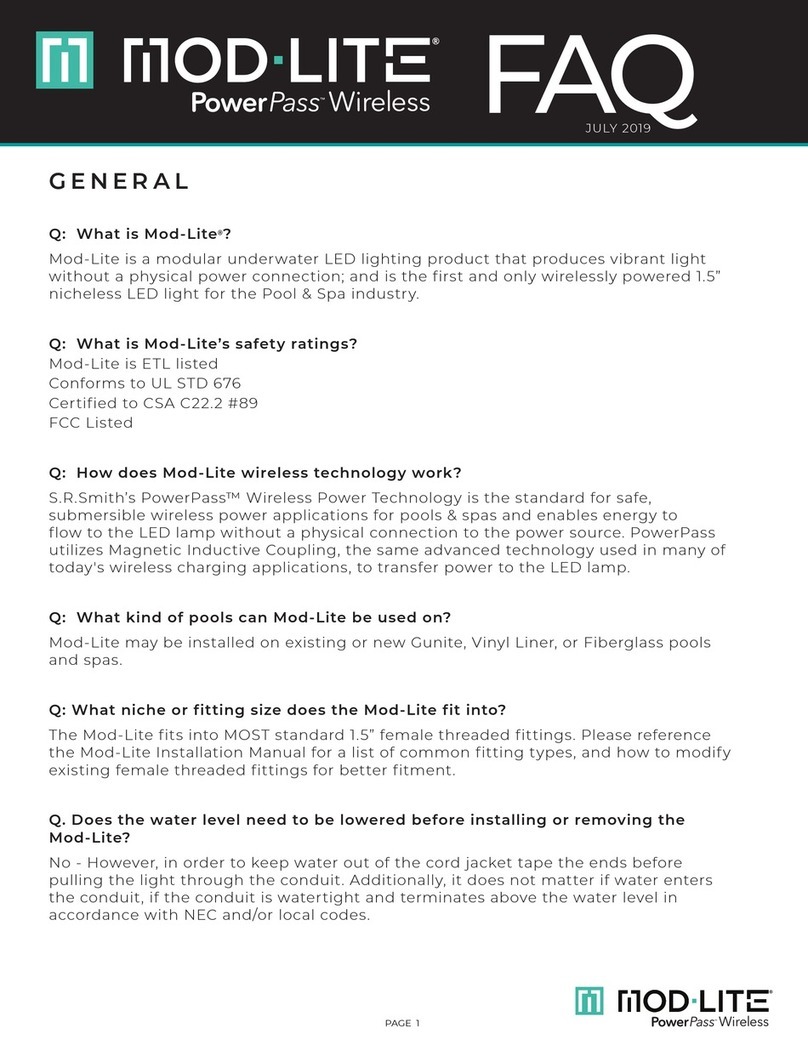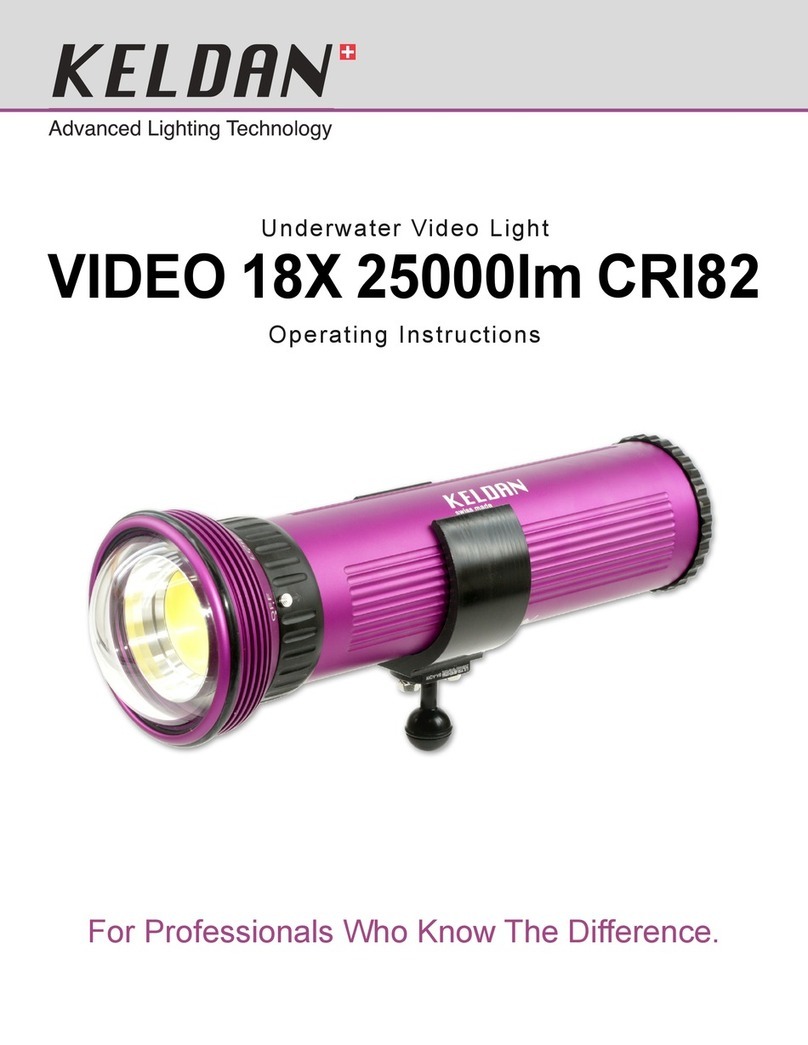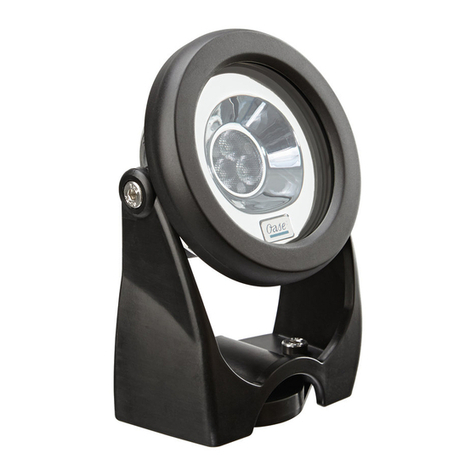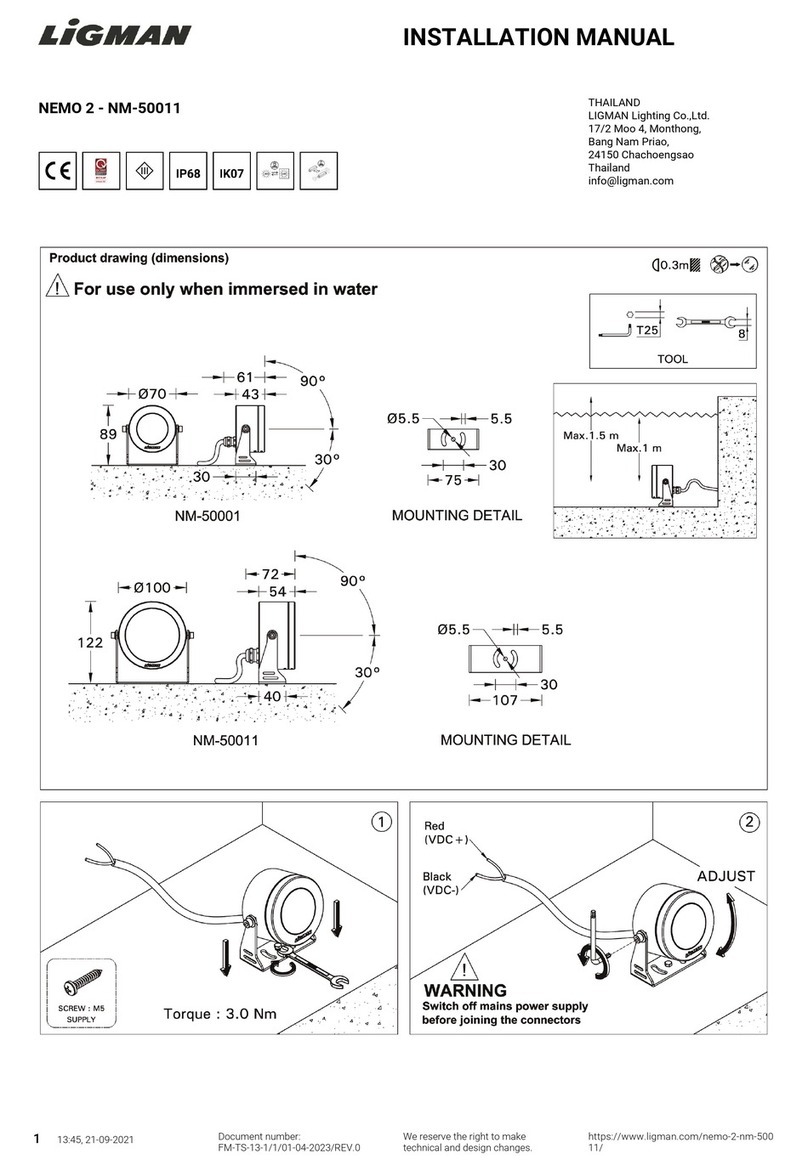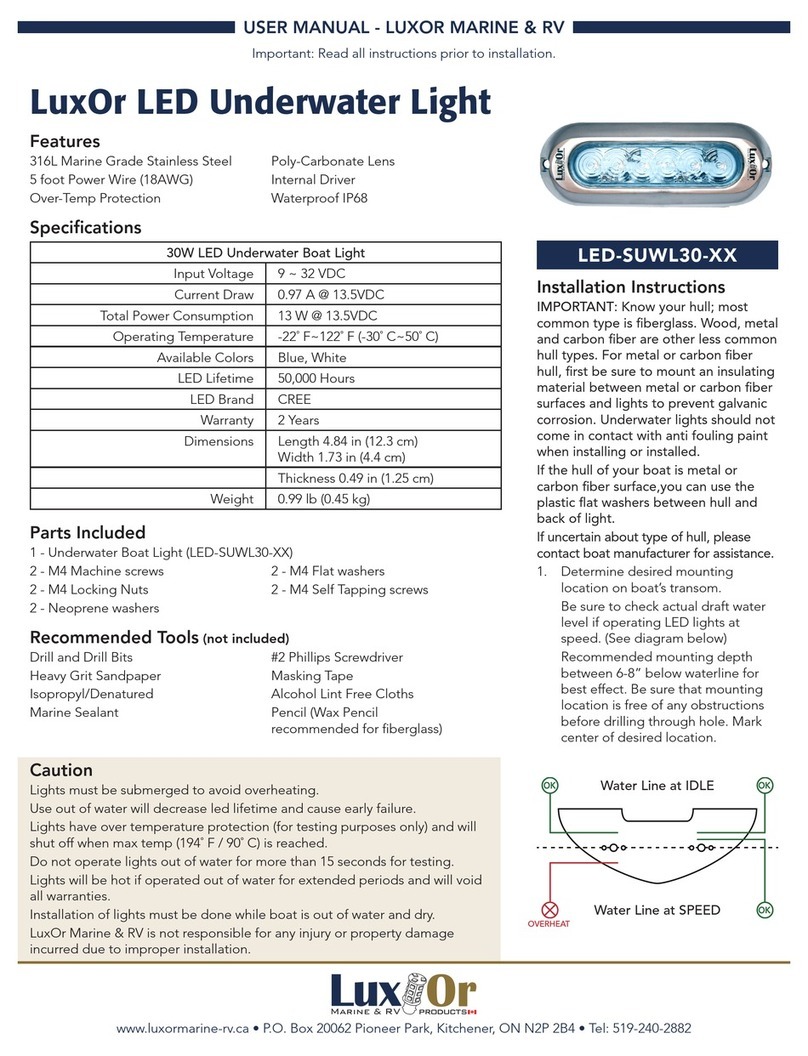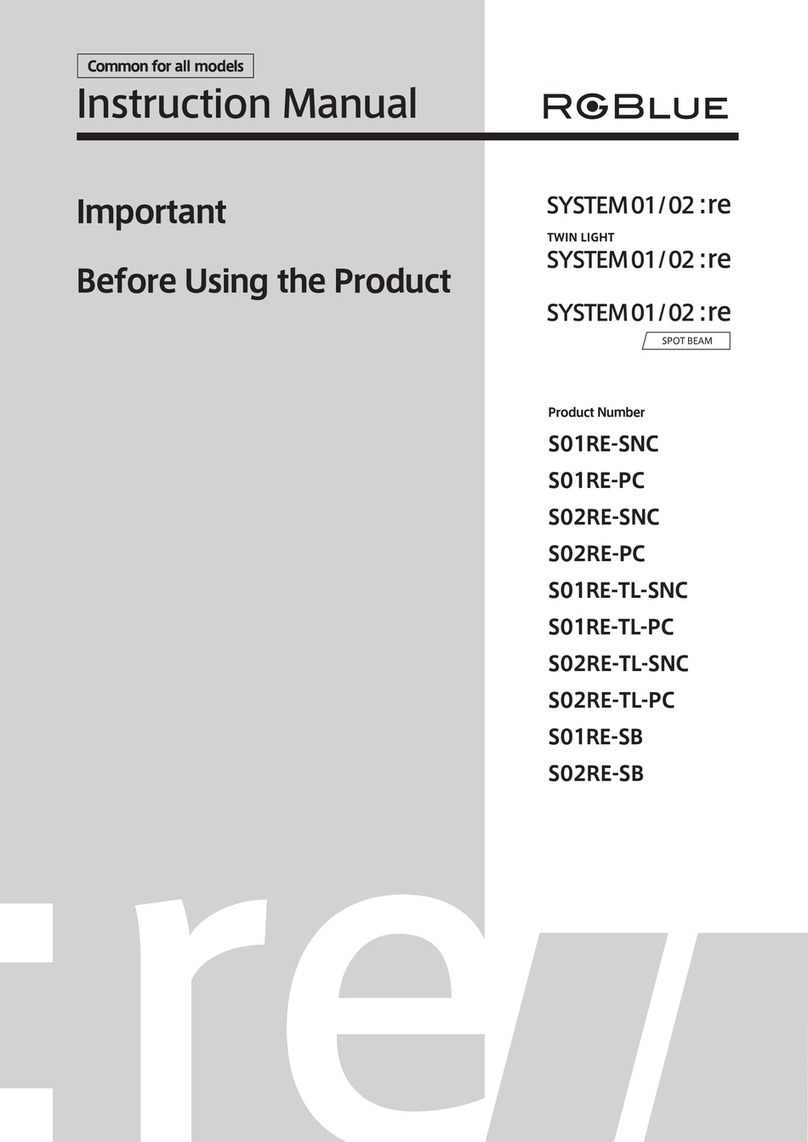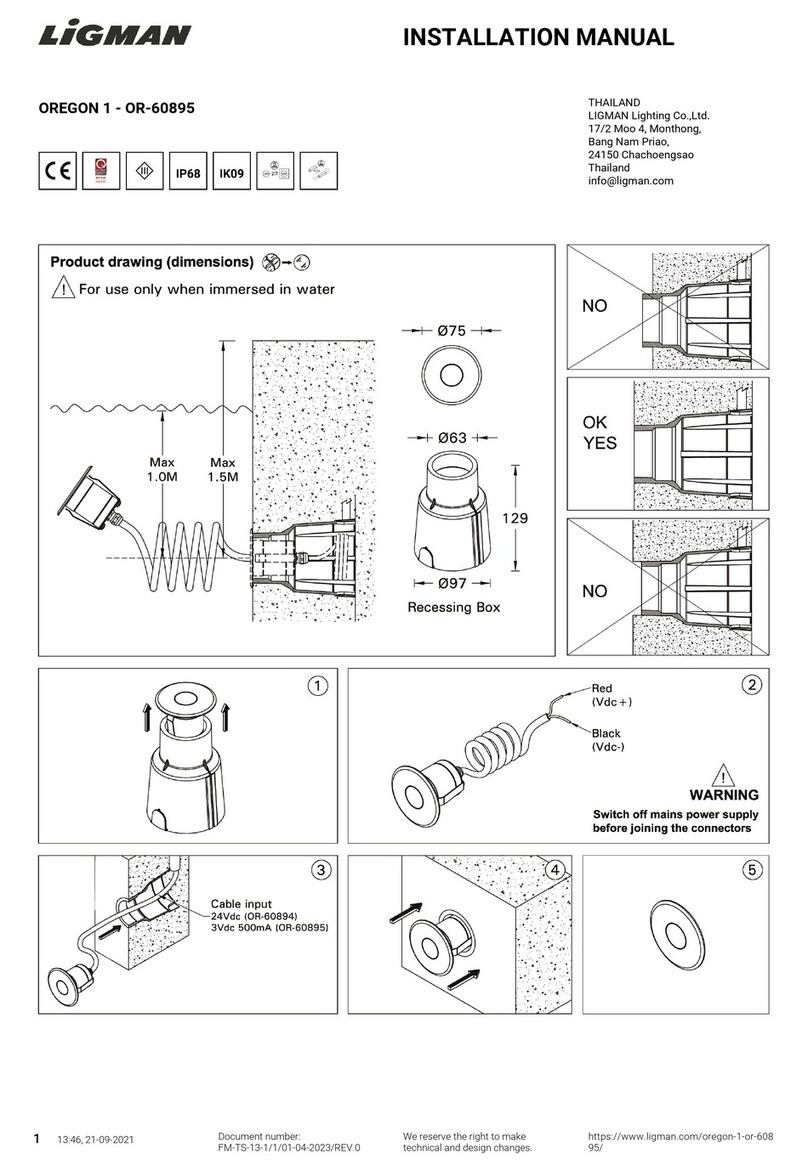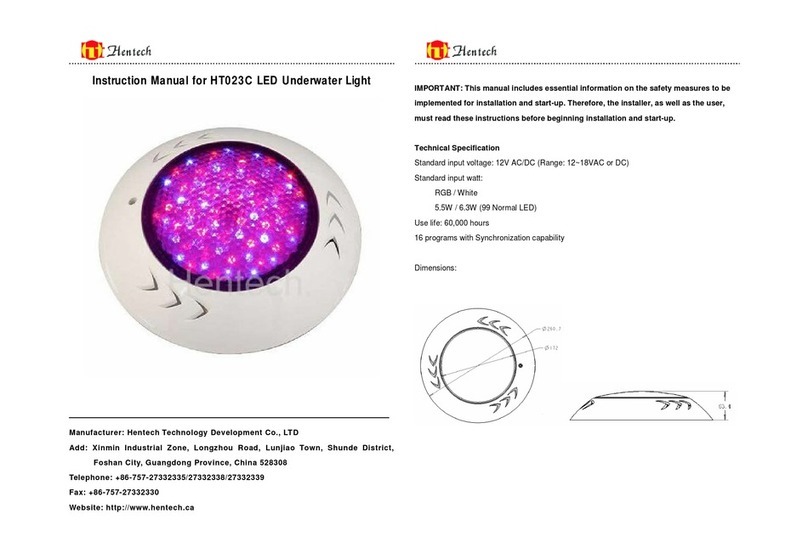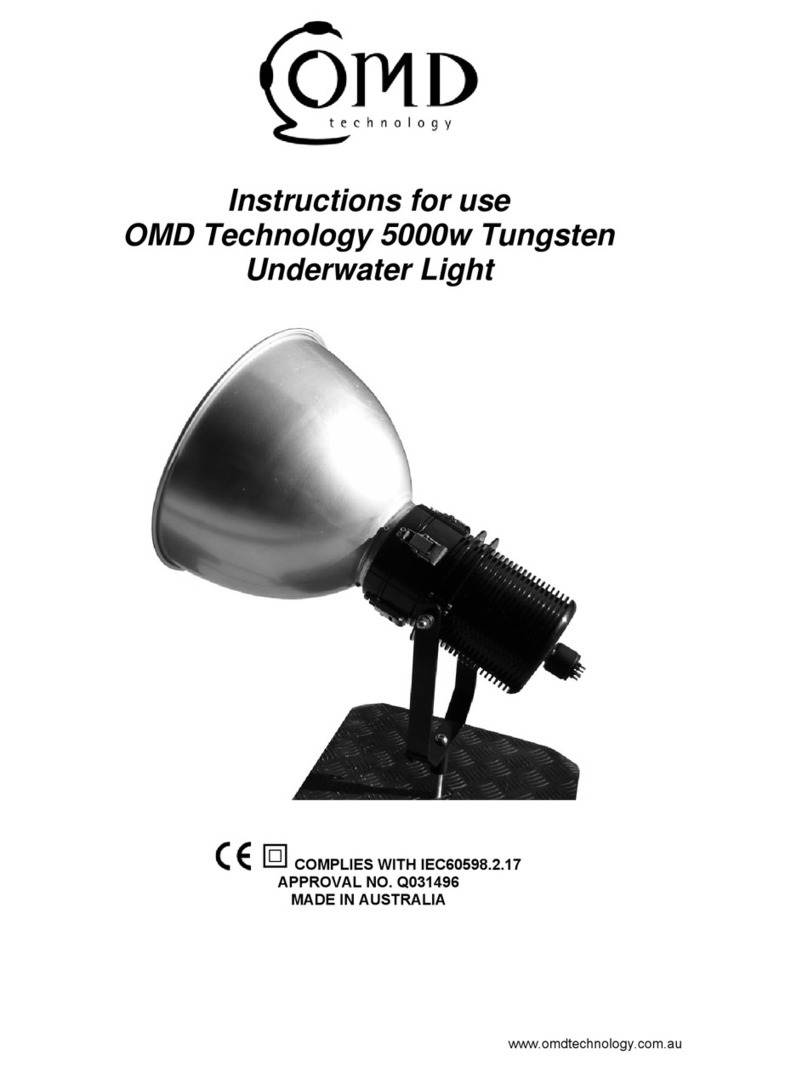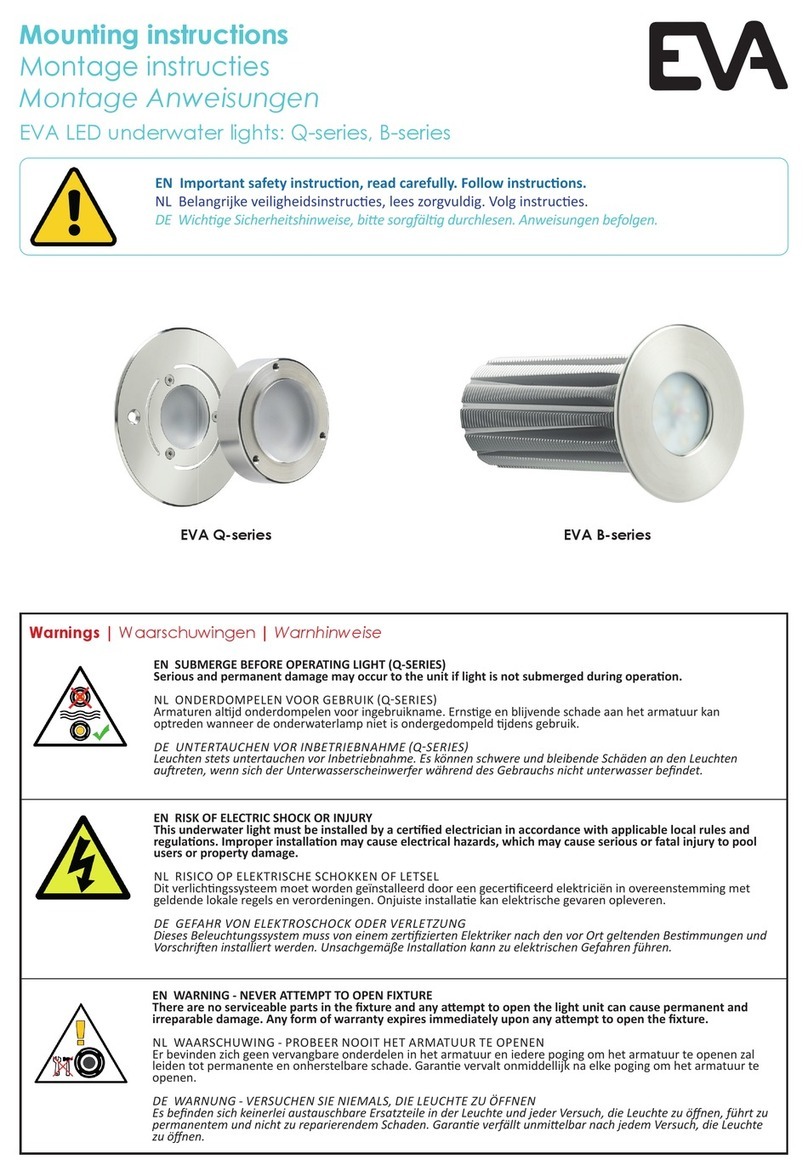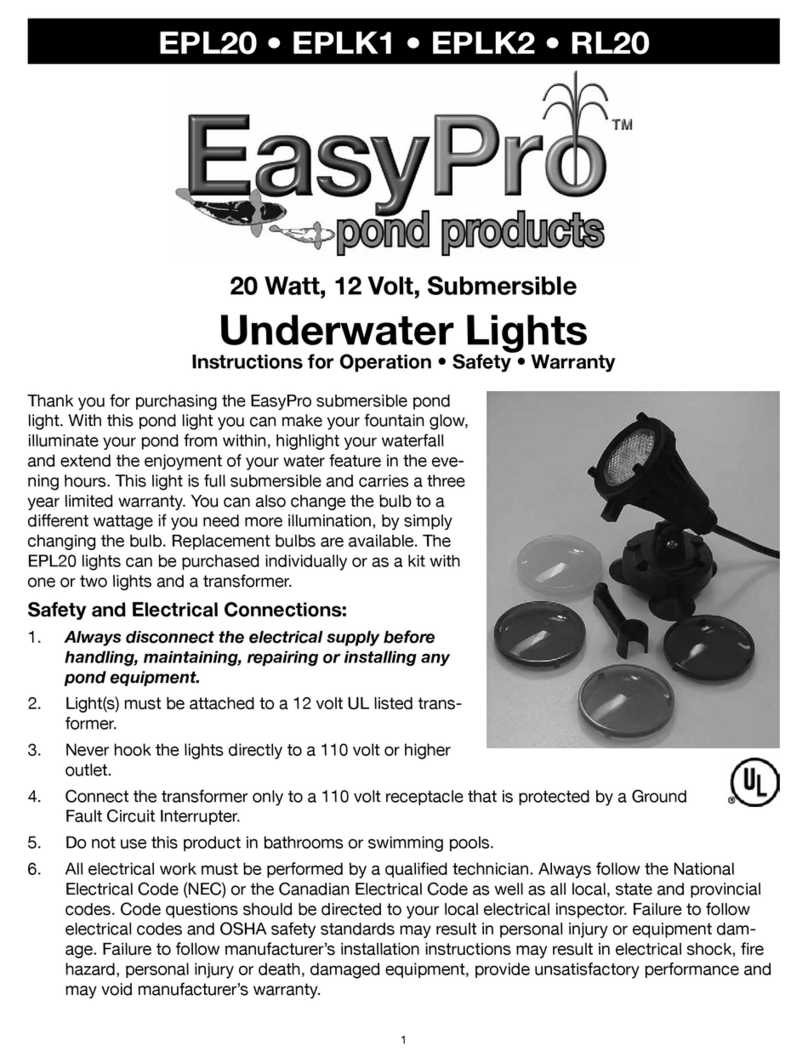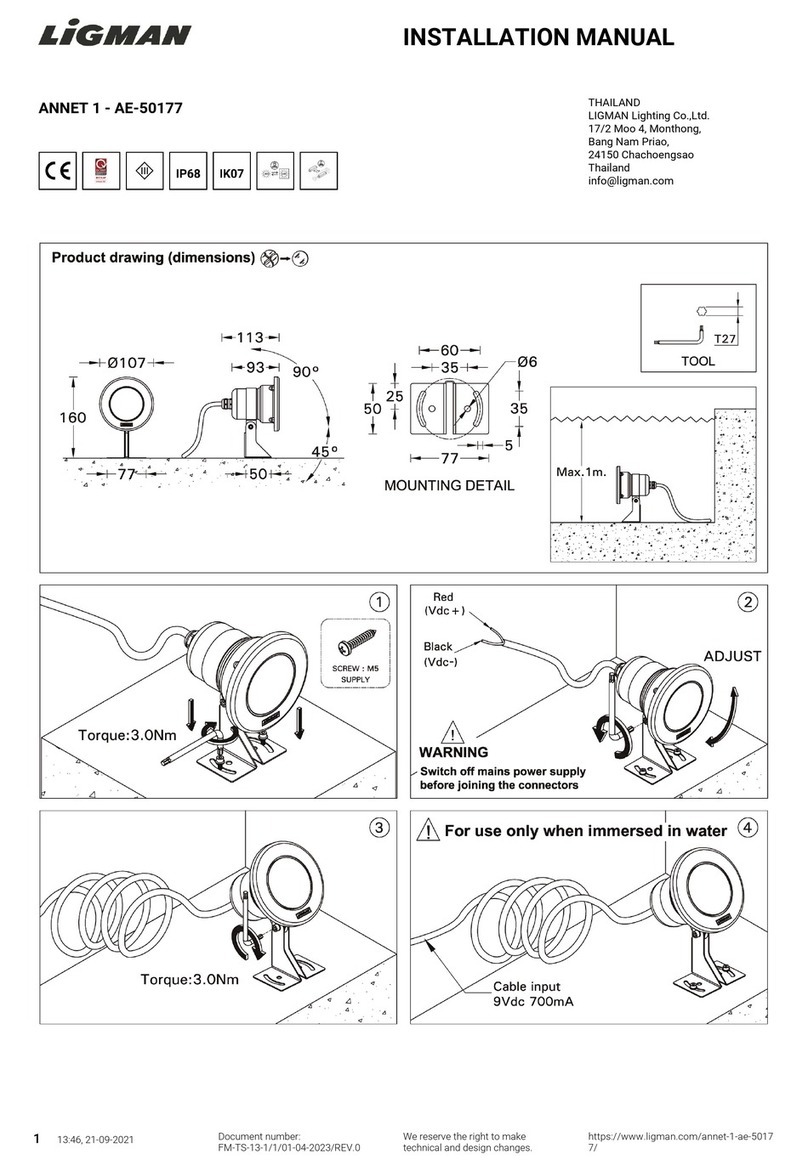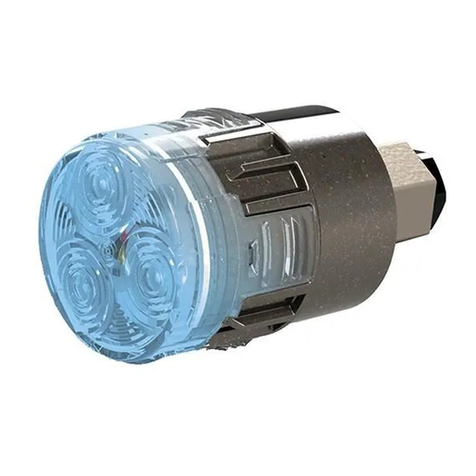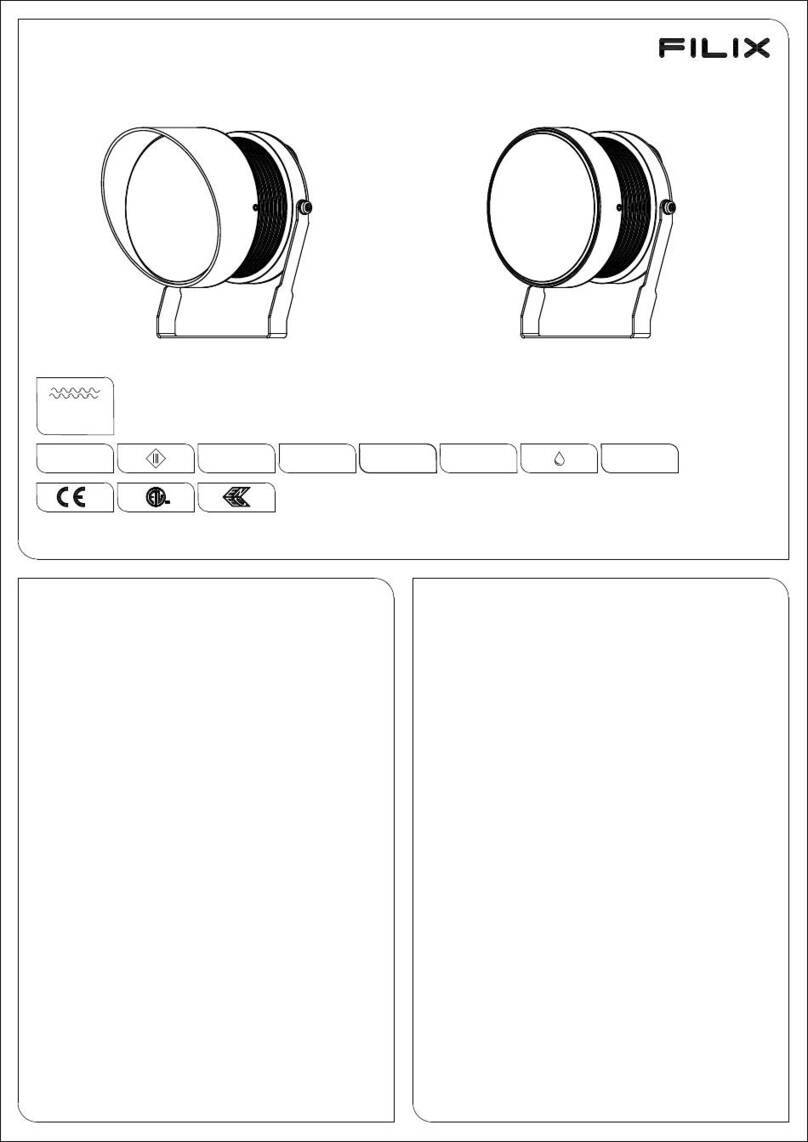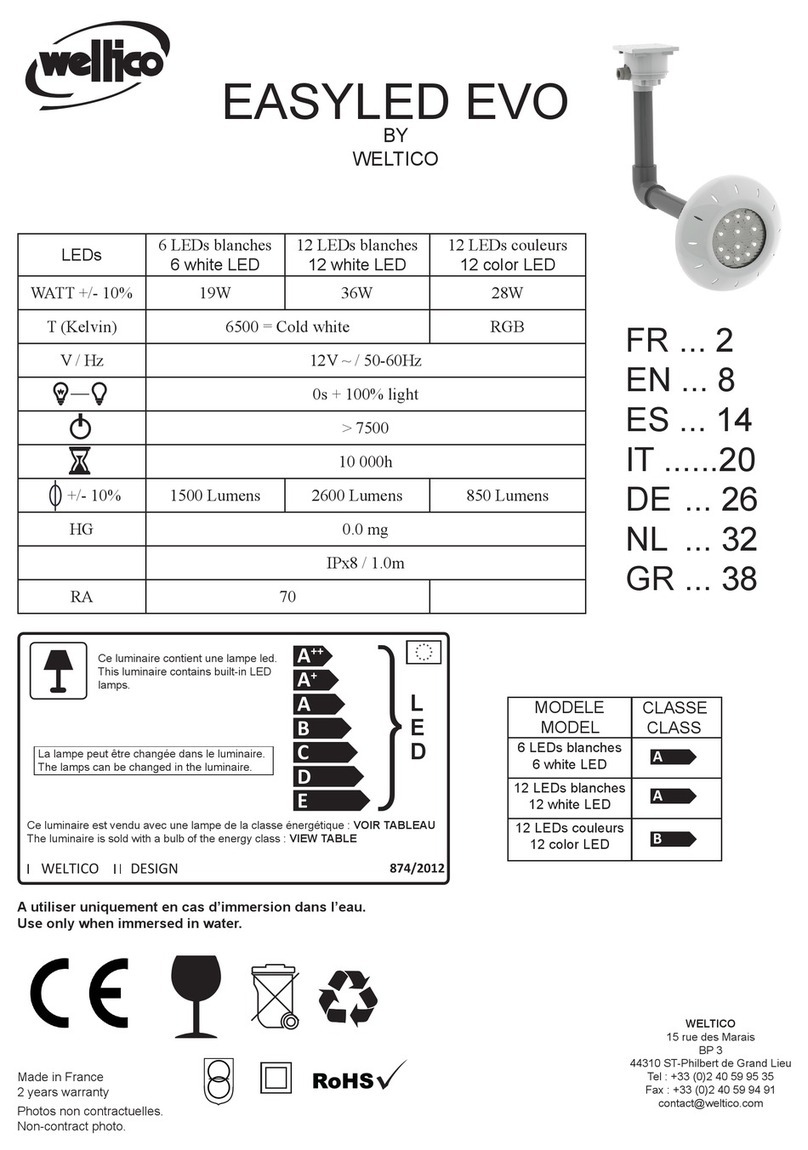
Insert the light on to the hull, feeding the cable through first and seat into
place. Press the light hard into the hull and ensure good adhesion.
3. To ensure correct dispersion of light underwater, ensure all Xtremes are
mounted with the correct orientation with text facing upwards. Tip: During/
after fitting process, ensure cable is not under any undue stress.
4. We recommend you only use the mounting screws provided. If alternative
screws are used, do not use counter sunk or non-flat shoulder screws.
Cover the threads with the sealant and screw into the pre-drilled pilot holes.
WARNING: Tighten the screws with a hand tool ONLY!
5. Once you are satisfied that the unit is fully embedded onto the hull, you will
notice that sealant has squeezed out from around the perimeter of the light.
Using a cloth wipe o excess sealant to leave a clean seal. If you do not see
sealant squeeze out from the body, you have not used enough sealant or
tightened the unit enough to the hull. Carefully examine the installation to
make sure the seal you have installed on the unit is fully water-tight. If in
doubt, remove light, re-apply sealant and re-install.
3. Connecting the light fixture
Warning: Always consult a qualified electrician when connecting OceanLED light
fixtures when connecting light units, please note that all OceanLED lights will
operate within a specific voltage range. Connecting lights to your V DC power
source it is recommended to connect the light to the DC power source using a
two pole, screw type terminal block with a minimum voltage rating of 50V and
a current rating of at least 5A. The ends of the cable should be stripped back (if
required) and suitable ferrules fitted. The terminal block should be fixed inside a
waterproof enclosure (IP66 minimum).
It is recommended to connect the light to the DC power source using a two
pole, screw type terminal block with a minimum voltage rating of 50V and a
current rating of at least 5A. The ends of the cable should be stripped back (if
required) and suitable ferrules fitted. The terminal block should be fixed inside a
waterproof enclosure (IP66 minimum).
Tip: Switch and breaker need to be robust enough to support light.
Tip: For complete instructions on V DC connections, please refer to ABYC codes
of practice and other applicable codes and ordinances for V DC connections.
Warning: Never leave the bare cables unprotected. Take care to not leave the
bare wire ends in bilge water before making the waterproof connections. Water
deposits in the connectors and cables will cause corrosion. Over time water
can also work its way into the unit along the inside of the cable due to capillary
action causing the light to fail. This will NOT be covered under warranty.
The colour change version of the X-Series can be used in one of two modes,
either by DC switch mode, or via DMX control mode. For DMX control mode, the
OceanDMX Xtreme Series Controller kit is required – please refer to the manual
included with the kit for connection details. For DC switch mode, connect the
red wire to the +ve supply, and the black, brown & yellow wires to the -ve supply:
1. Depending on the model of lights currently installed you will need to pull
the correct sized power cable from the breaker/fuse panel to the light
locations to supply constant power to the units. It is imperative that the
correct sized tinned boat cable is used.
2. Using waterproof butt splices or IP66 waterproof junction boxes, make
the connections at either end of the system to attach the lights to the vDC
system. If appropriate always use a dielectric grease when making the
connections and make sure any heat shrink used completely encapsulates
the outer wire sheath (the use of glue-lined heat shrink is highly
recommended to ensure water tightness).
NOTE: Corrosion of wire, and/or water ingress into the light unit via the
cable is NOT covered under warranty.
3. If you are not installing a custom fuse panel, it is imperative that the
OceanLED supplied fuse is installed on each power line from each light.
Please consult electrical specification in the online manual to select the
correct fuse dependant on which model of light you have.
Sealant
OceanLED makes every eort to protect our marine and fresh water
environment as well as our natural resources. Please take care to keep
packaging away from and out of the water by ensuring loose packaging
materials are secured and not susceptible to being blown into the water.
Please recycle all packaging materials as the sustainability of our environment
is everyone’s responsibility.
WARNING: Ensure mounting location is flat and check internally for ease of access or
if there is a rib, strut, stringer or other hull
irregularity
that may interfere with the
installation.
WARNING: Never use power tools to secure your lights; hand tighten only.
WARNING: We recommend you use screws provided. If alternative screws are used,
do not use counter sunk or non flat shoulder screws to secure your lights to the hull.
WARNING: All OceanLED in-water products require dry fitting. When installing, be
sure that the light fits the area and secures to the hull using the appropriate hardware
before applying any sealant.
WARNING: Light is for thru-hull mounting only. Cable and connections exposed to
underwater submersion will not be covered by warranty!
WARNING:There are several dierent hull types. Most are either solid GRP or
cored. Be sure you follow the correct procedures for the hull you are preparing
since all require dierent preparation methods. We will cover the most common
type below. If in doubt please contact your local OceanLED representative or the
boat manufacturer for assistance.
WARNING:Please check all components prior to installation. If there is any
damage to connectors, cables, and/or any other component, please notify
OceanLED BEFORE installation. Failure to notify OceanLED of damage in transit
prior to installation will lead to violation of warranty.
WARNING:Light is for mounting directly to a flat surface on the hull, with the
cable passing through a 1/2” (12.5mm) hole in the hull. Do not submerse your
cable in water; cable and connections exposed to underwater submersion will
not be covered by warranty. Mounting the light in any other configuration, other
than those described in this guide, will invalidate its warranty.
1. Preparing a fiberglass hull
Tip: Always wear safety goggles and a dust mask.
1. Drill a 3mm / 1/8” pilot hole square to mounting surface from inside the hull
if possible. If there is a rib, strut, or other hull irregularity near the selected
mounting location, this will need to be taken into account in the planning
phase and the location adjusted accordingly, or the obstruction safely
removed or modified. If the pilot hole is found to be drilled in the wrong
location, drill a second hole in a better location and repair first pilot hole.
2. Using a suitable drill, make a 1/2” (12.5mm) hole. Ensure the light will fit
flush and will be square to the mounting surface.
3. Sand the area around the hole using a heavy grit sandpaper to remove the
previous bottom paint and to ensure that the sealant will adhere properly
to the hull. If there is any petroleum residue inside the hull, remove it with
acetone before sanding.
4. Place light fixture into position or use mounting template provided. Mark
the screw hole position and pilot drill using correct sized drill bit for
included screws.
5. Always dry fit units before applying any sealant.
2. Installing the light fixture
TIP: Use a suitable marine sealant such as 3M™ Marine Adhesive Sealant Fast
Cure 4200FS. When applying sealant to light fixture, be careful to protect the
lens from any abrasive surface/floor so as not to remove the protective Tritonium
coating.
TIP: If bottom painting your lights ensure lens is free of any paint / residue.
1. Fit desired bezel over light unit.
2. Once hull preparation is complete (see step 1), the light can be inserted into
the hole previously prepared. Apply generous amounts of the sealant you
are using to the back perimeter of the light body. Make sure to generously
coat the cable of the light where it meets the back of the light. There
should be an unbroken bead of sealant around the perimeter of the light
unit.
TIP: It is critical to cover the entire body and circle the mounting screw hole
so that there is a continuous and unbroken bead of sealant.
